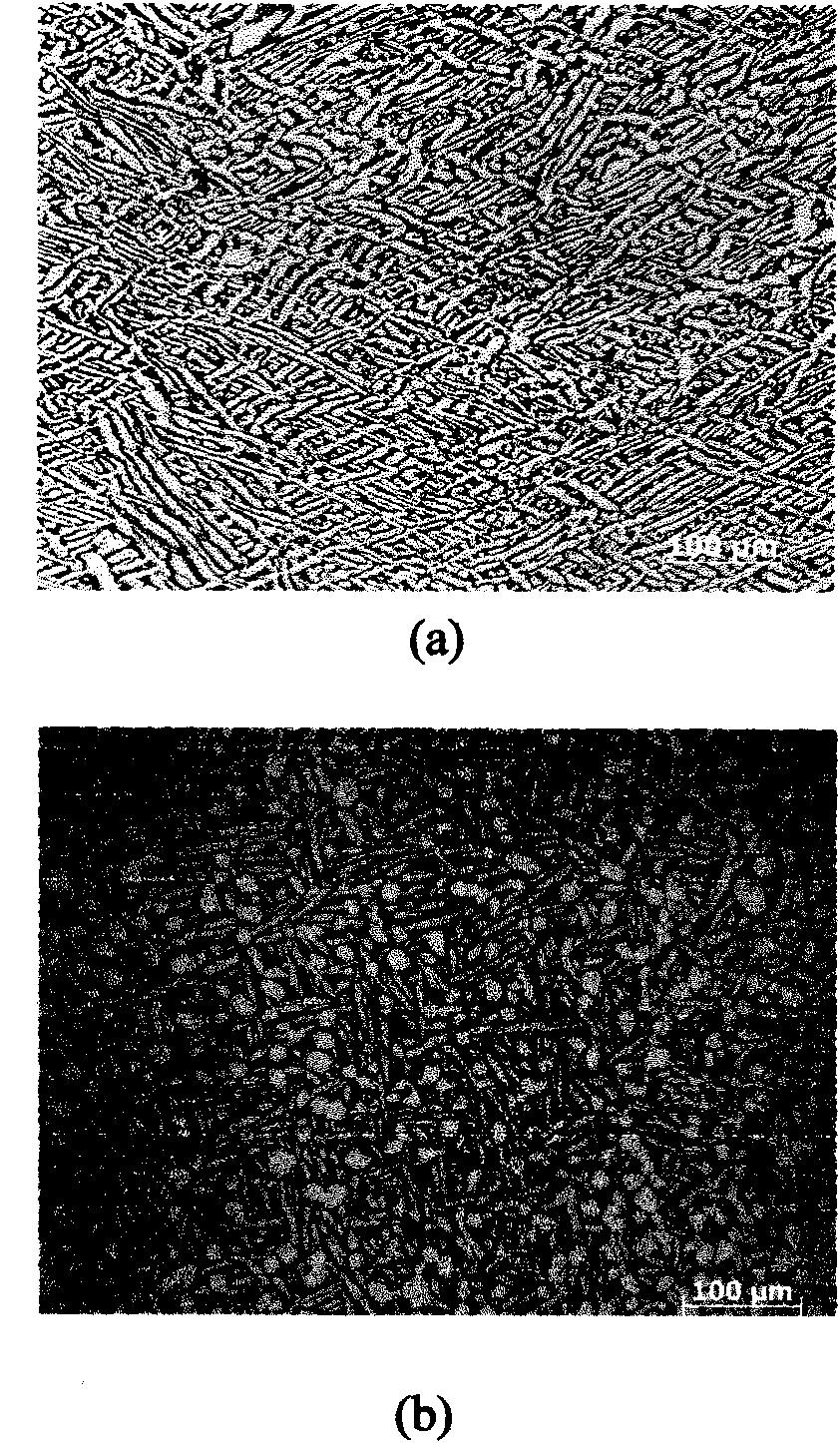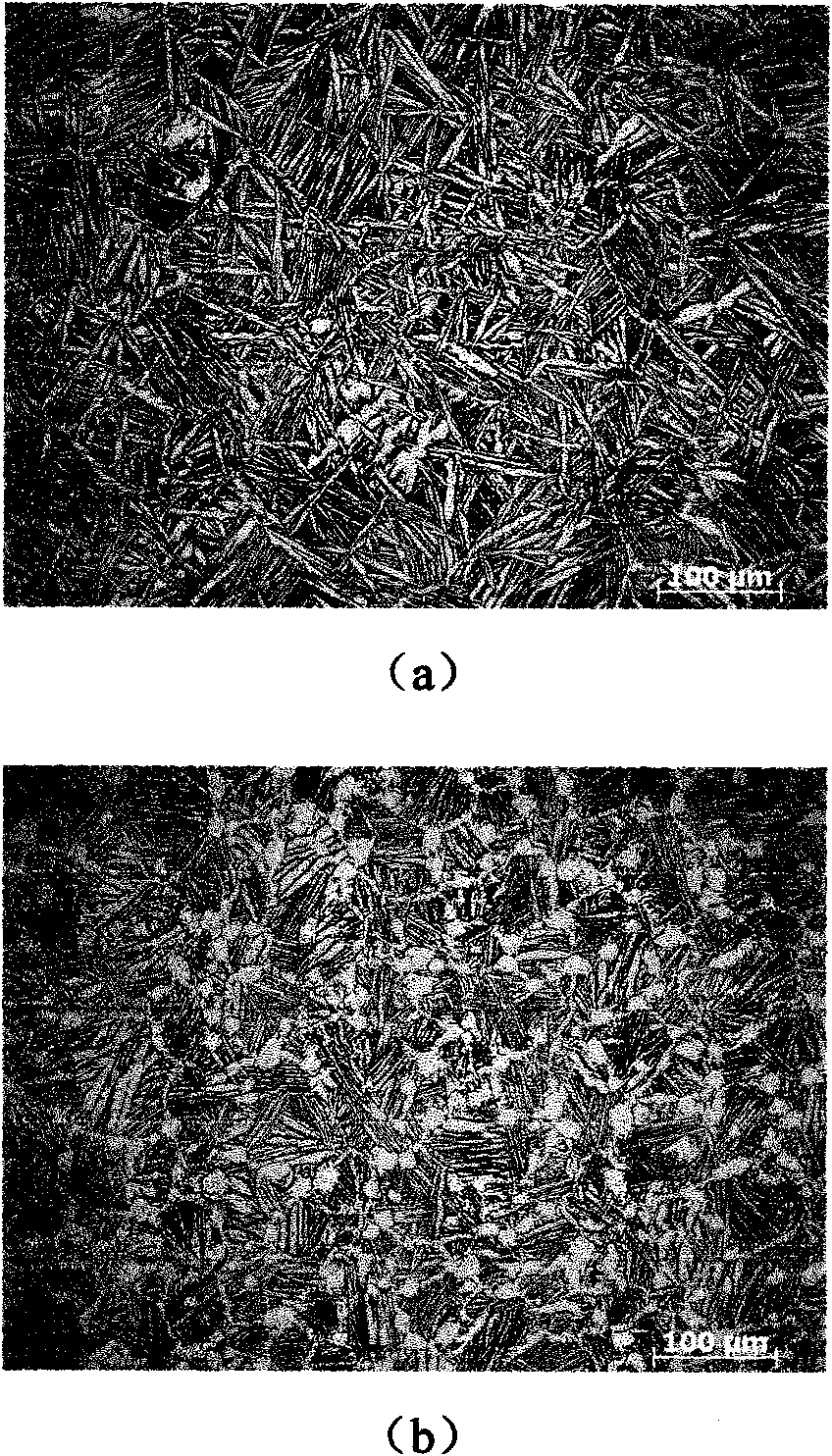Titanium alloy with thin sheet layer microstructure and manufacturing method thereof
A technology of microstructure and manufacturing method, applied in the field of titanium-based alloys, can solve the problems of difficult process control and strict requirements for alloy composition uniformity.
- Summary
- Abstract
- Description
- Claims
- Application Information
AI Technical Summary
Problems solved by technology
Method used
Image
Examples
Embodiment 1
[0035] According to the following formula: Al 5.8Wt-%, Sn 4.0Wt-%, Zr 5.0Wt-%, Mo 0.40Wt-%, Si0.5Wt-%, Nb 0.4Wt-%, Ta 2.5Wt-%, C 0.05Wt -% and balance of Ti. Sponge titanium, pure aluminum, sponge zirconium and intermediate alloy are mixed and pressed into electrodes, put into a vacuum consumable electric arc furnace for vacuum melting to obtain titanium alloy ingots. The α+β / β transformation point T of the material is measured by metallographic method α+β / β =1040°C, silicide dissolution temperature T sol = 1055°C. After the ingot is cut off and the surface defects are removed, the billet is opened by a hydraulic press at 1150°C, and the ingot is opened at 1060°C (T α+β / β +20℃) to make a Φ120 billet with a hydraulic press or a forging hammer, and use a precision forging machine to forge a Φ32 precision forged bar in two fires, where the heating temperature of the first fire is 1010℃ (T sol -45,T α+β / β -30℃), the forging ratio is 4; the second fire heating temperature is 1...
Embodiment 2
[0041] According to the following formula: Al 5.8Wt-%; Sn 4.0Wt-%; Zr 6.5Wt-%; Mo 0.40Wt-%; Si0.4Wt-%; Nb 0.4Wt-%; Ta 2.5Wt-%; -% and balance of Ti. The smelting and thermal processing techniques are the same as in Example 1. The α+β / β transformation point T of the material is measured by metallographic method α+β / β =1033°C, silicide dissolution temperature T sol =1050°C, the heat treatment system adopted is 1035°C / 2h solid solution, air cooling, and 700°C / 2h aging heat treatment to obtain Figure 4 The fine lamellar structure shown in (a), Figure 4 (b) and (c) are two-state and coarse lamellar structures with the same composition (comparative example), and the heat treatment systems are 1005°C / 2h solid solution, air cooling, 700°C / 2h aging and 1065°C / 2h solid solution, air cooling+ 700℃ / 2h aging, air cooling. Figure 4 (c) The microstructure solution treatment temperature is at the silicide dissolution temperature T sol Above, there is no silicide at this temperature, ...
Embodiment 3
[0047] Adopt the same alloy composition and smelting process as in Example 2 to produce disc-shaped parts, after cutting off the cap and removing surface defects, enter the following processing steps: 1) blanking with a hydraulic press at 1200 ° C, the forging ratio is 2.25 , 2) at 1020°C (T sol -30) Heating, upsetting with a hydraulic press, the total forging ratio is 3.3, water quenching after forging; 3) heating at 1050°C (17°C above the α+β / β phase transition point), upsetting with a hydraulic press, the total forging Ratio of 4.1, water quenching after forging; 4) at 1020°C (T sol -30) Heating, upsetting and drawing with a hydraulic press, the total forging ratio is 3.3, water quenching after forging; 5) at 1010°C (T sol -40°C, T α+β / β -23°C) heating, hydraulic press for upsetting, the total forging ratio is 4.5, water quenching after forging; 6) heat treatment: 1040°C / 2h, oil quenching +700°C / 5h, air cooling. Its organization is fine lamellar microstructure, see appen...
PUM
| Property | Measurement | Unit |
|---|---|---|
| particle size | aaaaa | aaaaa |
Abstract
Description
Claims
Application Information
 Login to View More
Login to View More - R&D
- Intellectual Property
- Life Sciences
- Materials
- Tech Scout
- Unparalleled Data Quality
- Higher Quality Content
- 60% Fewer Hallucinations
Browse by: Latest US Patents, China's latest patents, Technical Efficacy Thesaurus, Application Domain, Technology Topic, Popular Technical Reports.
© 2025 PatSnap. All rights reserved.Legal|Privacy policy|Modern Slavery Act Transparency Statement|Sitemap|About US| Contact US: help@patsnap.com



